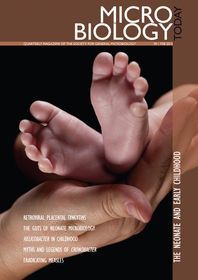The neonate and early childhood
01 February 2012 publication
This issue looks at the positive and negative effects of bacteria and viruses on the human body at one of the most vulnerable times of our life.
Retroviral placental syncytins: old dogs with new tricks (p. 18)
Although retroviruses are often associated with disease, retroviral DNA sequences have been found in many mammalian genomes. Far from being inert pieces of junk DNA, some of these sequences have acquired important functions, for example in the development of the placenta, as David Griffiths explains.
Microbiology of the neonate: getting to the guts of it (p. 22)
It is a well-known fact that most of the cells in the human body are not mammalian but microbial. Anne McCartney asks when and how do we acquire our microbiota?
Helicobacter pylori infection in childhood (p. 26)
Although our understanding of Helicobacter pylori is not complete, we do know that infection with this bacterium can cause problems in both children and adults. But is there a positive side to colonization by this bacterium? Karen Robinson and Richard Ingram discuss.
Myths and legends of Cronobacter – a new bacterial pathogen of babies? (p. 30)
Many microbiologists in recent years have heard of the ‘novel’ bacterium Cronobacter, probably because of its association with severe, often fatal, infections of babies. However, as Stephen Forsythe explains, accurate information on this organism is not so easily acquired as its emergence has been convoluted and prone to misunderstanding.
Can measles be eradicated? (p. 34)
As Philip Mortimer says, mallpox was globally eradicated over 30 years ago. So, what about measles?
Schoolzone (p. 38)
Fighting fit and algal antics; Vicki Symington describes SGM’s time at the ASE in Liverpool.
Gradline (p. 42)
2012 will see the 10th winner of The Sir Howard Dalton Young Microbiologist of the Year competition. In this issue of Gradline, Karen McGregor talks to finalists from the previous 10 years about their experience of the competition and the importance of developing good communication skills for a career in science. Previous winners give their tips for success to the 2012 finalists.
Media (p. 47)
Laura Udakis describes Sense About Science ‘Ask for Evidence’, and Benjamin Thompson and Matt Hutchings talk about their ‘Microbelog’.
Public Affairs (p. 50)
SGM member Profesor Anne Glover has been appoionted as Chief Scientific Advisor to the European Union President, and in this issue she answers questions about her new role. In addition, we report on the launch of ‘Antibiotic Action’, an initiative of the British Society for Antimicrobial Chemotherapy.
Going Public (p. 56)
Joanna Verran reports on microbiology at the Manchester Science Festival.
Comment: Stop bugging me! (p. 68)
A listening device, an annoyance, an illness or an indiscriminate term for various types of microbe. Laura Bowater asks what is
a ‘bug’, and does it have any place in microbiological parlance?

